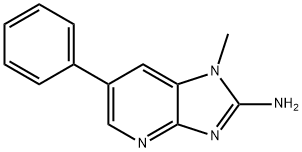105650-23-5
中文名稱
2-氨基-1-甲基-6-苯基咪唑[4,5-b]吡啶
英文名稱
2-AMINO-1-METHYL-6-PHENYLIMIDAZO[4,5-B]PYRIDINE
CAS
105650-23-5
分子式
C13H12N4
MDL 編號(hào)
MFCD00210745
分子量
224.26
MOL 文件
105650-23-5.mol
 105650-23-5 結(jié)構(gòu)式
105650-23-5 結(jié)構(gòu)式
基本信息
中文別名
2-氨基-1-甲基-6-苯基咪唑[4,5-b]吡啶 英文別名
2-AMINO-1-METHYL-6-PHENYLIMIDAZO[4,5-B]PYRIDINEPHIP
5-b)pyridin-2-amine,1-methyl-6-phenyl-1h-imidazo(
5-b)pyridine,2-amino-1-methyl-6-phenyl-1h-imidazo(
5-b)pyridine,2-amino-1-methyl-6-phenyl-imidazo(
Amino-1-methyl-6-phenylimidazo[4.5-b]pyridine
1-Methyl-6-phenyl-1H-imidazo[4,5-b]pyridin-2-amine
2-AMINO-1-METHYL-6-PHENYLIMADAZO(4,5-B)PYRIDINE
2-AMINO-1-METHYL-6-PHENYL-1H-IMIDAZO[4,5-B]PYRIDINE
2-AMINO-1-METHYL-6-PHENOLIMIDAZO[4,5-B]PYRIDINE
2-Amino-1-methyl-6-phenylimidazo[4,5,b]pyridine, (PhIP)
1-Methyl-6-phenyl-1H-imidazo[4,5-β]pyridin-2-amine
2-Amino-1-methyl-6-phenylimidazo[4,5-β]pyridine
物理化學(xué)性質(zhì)
熔點(diǎn)300
沸點(diǎn)355.66°C (rough estimate)
密度1.2067 (rough estimate)
折射率1.5890 (estimate)
儲(chǔ)存條件Refrigerator
溶解度DMF: 10 mg/ml; DMSO: 10 mg/ml; Ethanol: 15 mg/ml; Ethanol:PBS (pH 7.2) (1:3): 0.25 mg/ml
酸度系數(shù)(pKa)7.72±0.30(Predicted)
形態(tài)結(jié)晶固體
顏色White to light yellow
生物來源synthetic
CAS 數(shù)據(jù)庫105650-23-5(CAS DataBase Reference)
(IARC)致癌物分類2B (Vol. 56) 1993
安全數(shù)據(jù)
警示詞危險(xiǎn)
危險(xiǎn)性描述H302+H312-H315-H319-H331-H335-H350-H360
危險(xiǎn)品標(biāo)志T
Hazard NoteToxic
海關(guān)編碼29332900
毒害物質(zhì)數(shù)據(jù)105650-23-5(Hazardous Substances Data)
105650-23-5(安全特性,毒性,儲(chǔ)運(yùn))
儲(chǔ)運(yùn)特性
庫房通風(fēng)低溫干燥可燃性危險(xiǎn)特性
可燃;燃燒產(chǎn)生有毒氮氧化物煙霧類別
有毒物品滅火劑
干粉、泡沫、砂土、二氧化碳, 霧狀水2-氨基-1-甲基-6-苯基咪唑[4,5-b]吡啶價(jià)格(試劑級(jí))
| 報(bào)價(jià)日期 | 產(chǎn)品編號(hào) | 產(chǎn)品名稱 | CAS號(hào) | 包裝 | 價(jià)格 |
| 2025/02/08 | HY-118716 | 2-氨基-1-甲基-6-苯基咪唑[4,5-b]吡啶 PhIP | 105650-23-5 | 1 mg | 1600元 |
| 2025/02/08 | HY-118716 | 2-氨基-1-甲基-6-苯基咪唑[4,5-b]吡啶 PhIP | 105650-23-5 | 5 mg | 3400元 |
| 2025/02/08 | HY-118716 | 2-氨基-1-甲基-6-苯基咪唑[4,5-b]吡啶 PhIP | 105650-23-5 | 10 mM * 1 mLin DMSO | 3947元 |
常見問題列表
生物活性
PhIP 是在熟肉中形成的雜環(huán)芳香胺 (HAA),是一種可能的致癌物。具有 DNA 破壞性和誘變性。 PhIP 還具有雌激素活性,可能有助于其組織特異性致癌性。體外研究
PhIP causes widespread and largely over-lapping effects on miRNA expression. PhIP induces widespread effects via activation of oestrogen receptor alpha (ERα). Deregulation of miRNA by PhIP could potentially be an important non-DNA-damaging carcinogenic mechanism in breast cancer.
體內(nèi)研究
In hCYP1A-mice, PhIP induces inflammation, epithelial cell damage, and prostatic intraepithelial neoplasia in the dorsolateral prostate lobe compared to the ventral lobe. PhIP forms DNA adducts in the prostate, PhIP also induces oxidative stress, atrophy of the acini, and inflammation of the prostate of rodents.

